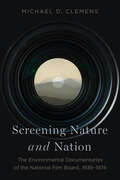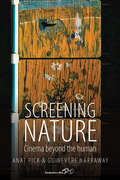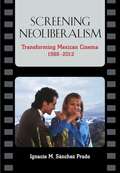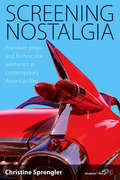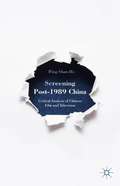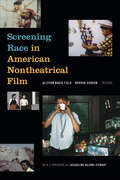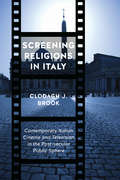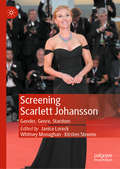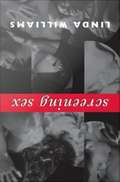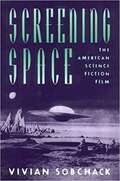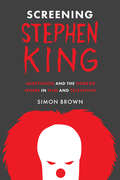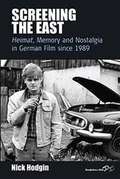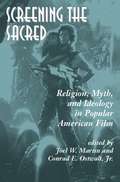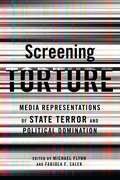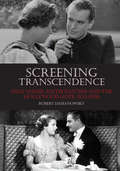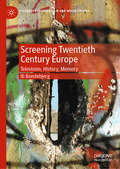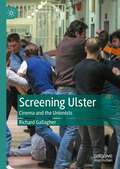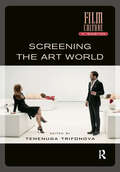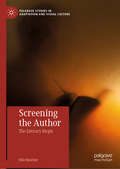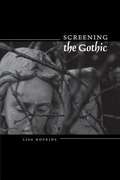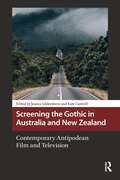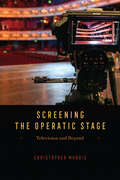- Table View
- List View
Screening Nature and Nation: The Environmental Documentaries of the National Film Board, 1939-1974
by Michael D. ClemensThe stunning portrayals of the Canadian landscape in the documentaries produced by the National Film Board of Canada, not only influenced cinematic language but shaped our perception of the environment. In the early days of the organization, nature films produced by the NFB supported the Canadian government’s nation-building project and show the state as an active participant in the cultural construction of the land. By the mid-1960s however, films like Cree Hunters of Mistassini and Death of a Legend were asking provocative questions about the state’s vision of nature. Filmmakers like Boyce Richardson and Bill Mason began to centre the experiences of First Nations people, contest the notion that nature should be transformed for economic gain, and challenge the idea that the North is a wild and empty landscape bereft of civilization. Author Michael Clemens describes how films produced by the NFB broadened the ecological imagination of Canadians over time and ultimately inspired an environmental movement.
Screening Nature: Cinema beyond the Human
by Anat Pick and Guinevere NarrawayEnvironmentalism and ecology are areas of rapid growth in academia and society at large. Screening Nature is the first comprehensive work that groups together the wide range of concerns in the field of cinema and the environment, and what could be termed “posthuman cinema.” It comprises key readings that highlight the centrality of nature and nonhuman animals to the cinematic medium, and to the language and institution of film. The book offers a fresh and timely intervention into contemporary film theory through a focus on the nonhuman environment as principal register in many filmic texts. Screening Nature offers an extensive resource for teachers, undergraduate students, and more advanced scholars on the intersections between the natural world and the worlds of film. It emphasizes the cross-cultural and geographically diverse relevance of the topic of cinema ecology.
Screening Neoliberalism: Transforming Mexican Cinema, 1988-2012
by Ignacio M. Sanchez PradoCavernous, often cold, always dark, with the lingering smell of popcorn in the air: the experience of movie-going is universal. The cinematic experience in Mexico is no less profound, and has evolved in complex ways in recent years. Films like Y Tu Mama Tambien, El Mariachi, Amores Perros, and the work of icons like Guillermo del Toro and Salma Hayek represent much more than resurgent interest in the cinema of Mexico. In Screening Neoliberalism, Ignacio Sanchez Prado explores precisely what happened to Mexico's film industry in recent decades. Far from just a history of the period, Screening Neoliberalism explores four deep transformations in the Mexican film industry: the decline of nationalism, the new focus on middle-class audiences, the redefinition of political cinema, and the impact of globalization. This analysis considers the directors and films that have found international notoriety as well as those that have been instrumental in building a domestic market. Screening Neoliberalism exposes the consequences of a film industry forced to find new audiences in Mexico's middle-class in order to achieve economic and cultural viability.
Screening Neoliberalism: Transforming Mexican Cinema, 1988-2012
by Ignacio Sanchez PradoCavernous, often cold, always dark, with the lingering smell of popcorn in the air: the experience of movie-going is universal. The cinematic experience in Mexico is no less profound, and has evolved in complex ways in recent years. Films like Y Tu Mama Tambien, El Mariachi, Amores Perros, and the work of icons like Guillermo del Toro and Salma Hayek represent much more than resurgent interest in the cinema of Mexico. In Screening Neoliberalism, Ignacio Sanchez Prado explores precisely what happened to Mexico's film industry in recent decades. Far from just a history of the period, Screening Neoliberalism explores four deep transformations in the Mexican film industry: the decline of nationalism, the new focus on middle-class audiences, the redefinition of political cinema, and the impact of globalization. This analysis considers the directors and films that have found international notoriety as well as those that have been instrumental in building a domestic market. Screening Neoliberalism exposes the consequences of a film industry forced to find new audiences in Mexico's middle-class in order to achieve economic and cultural viability.
Screening Nostalgia
by Christine Sprengler"In this fascinating in-depth study of the impact of nostalgia on contemporary American cinema, Christine Sprengler unpicks the history of the concept and explores its significance in theory and practice. She offers a lucid analysis of the development of nostalgia in American society and culture, navigating a path through the key debates and aligning herself with recent attempts to recuperate its critical potential. This journey opens up the myriad permutations of nostalgia across visual and material culture and their interface with cinema, with the 1950s emerging as a privileged moment. Four case studies (Sin City, Far From Heaven, The Aviator and The Good German) analyse the ways in which aspects of visual design such as props, costume and colour contribute to the nostalgic aesthetic, allowing for both critical distance and emotion. Written with verve, style and impressive attention to detail, Screening Nostalgia is an invaluable addition to existing scholarship. It is also essential reading for anyone interested in the ways in which we access the past through cinema." · Pam Cook, Professor Emerita in Film, University of Southampton
Screening Post-1989 China
by Wing Shan HoThis unique book investigates the tug-of-war between the free market economy and authoritative state regulation in Chinese culture after 1989. Contextualizing close textual readings of cinematic and television texts, both officially sanctioned and independently made, Wing Shan Ho illuminates the complex process in which cultural producers and consumers negotiate with both the state and the market in articulating new forms of subjectivity. Ho examines the types of Chinese subjects that the state applauds and aggrandizes in contrast to those that it condemns and attempts to eliminate. Her focus on the socialist spirit exposes inherent contradictions in the current Chinese project of nation-building. This comparative study shines a harsh light on these cultural products and on much more: the confluence between commerce and politics and popular culture, the interaction between state and individuals in popular culture, and the complexity of governmentality in an era of globalization.
Screening Race in American Nontheatrical Film
by Allyson Nadia Field Marsha GordonAlthough overlooked by most narratives of American cinema history, films made for purposes outside of theatrical entertainment dominated twentieth-century motion picture production. This volume adds to the growing study of nontheatrical films by focusing on the ways filmmakers developed and audiences encountered ideas about race, identity, politics, and community outside the borders of theatrical cinema. The contributors to Screening Race in American Nontheatrical Film examine the place and role of race in educational films, home movies, industry and government films, anthropological films, and church films as well as other forms of nontheatrical filmmaking. From filmic depictions of Native Americans and films by 1920s African American religious leaders to a government educational film about the unequal treatment of Latin American immigrants, these films portrayed—for various purposes and intentions—the lives of those who were mostly excluded from the commercial films being produced in Hollywood. This volume is more than an examination of a broad swath of neglected twentieth-century filmmaking; it is a reevaluation of basic assumptions about American film culture and the place of race within it. Contributors. Crystal Mun-hye Baik, Jasmyn R. Castro, Nadine Chan, Mark Garrett Cooper, Dino Everett, Allyson Nadia Field, Walter Forsberg, Joshua Glick, Tanya Goldman, Marsha Gordon, Noelle Griffis, Colin Gunckel, Michelle Kelley, Todd Kushigemachi, Martin L. Johnson, Caitlin McGrath, Elena Rossi-Snook, Laura Isabel Serna, Jacqueline Najuma Stewart, Dan Streible, Lauren Tilton, Noah Tsika, Travis L. Wagner, Colin Williamson
Screening Religions in Italy: Contemporary Italian Cinema and Television in the Post-secular Public Sphere (Toronto Italian Studies)
by Clodagh J. BrookReligion has had been foundational in shaping Italy. Home to the Vatican State, the Italian peninsula is the religious centre for one billion Catholics globally. It is also increasingly home to those of other faiths, especially Islam. Italy’s development as a contemporary post-secular and multi-religious society is fraught and fascinating. The recent return of religious discourse from the margins of Western society to a central position is a sign of what German philosopher, Jürgen Habermas, has defined as the post-secular condition. Habermas and others have questioned what most people in the West had, up to a few years ago, taken for granted: the unstoppable forward march of secularization and the subsequent marginalization of religion. Instead, one of the greatest global fault-lines in the contemporary world – the divide between absolutist extremist Islamic faith and liberal, but Christian-inflected, secular values – has religious identity at its core. The first book-length study to examine religion in contemporary Italian cinema and television fiction, Screening Religions in Italy identifies two key issues: how Italian filmmaking constructs the continuing position of religion in the public sphere and why religion persists on Italian screens. It spans genres such as horror, comedy, hagiopics, and TV fiction, and explores both commercial and art-house filmmaking. It treats films and television series that range from Moretti’s Habemus Papam to Sorrentino’s The Young Pope.
Screening Scarlett Johansson: Gender, Genre, Stardom
by Whitney Monaghan Kirsten Stevens Janice LoreckScreening Scarlett Johansson: Gender, Genre, Stardom provides an account of Johansson’s persona, work and stardom, extending from her breakout roles in independent cinema, to contemporary blockbusters, to her self-parodying work in science-fiction. Screening Scarlett Johansson is more than an account of Johansson’s career; it positions Johansson as a point of reference for interrogating how femininity, sexuality, identity and genre play out through a contemporary woman star and the textual manipulations of her image. The chapters in this collection cast a critical eye over the characters Johansson has portrayed, the personas she has inhabited, and how the two intersect and influence one another. They draw out the multitude of meanings generated through and inherent to her performances, specifically looking at processes of transformation, metamorphosis and self-deconstruction depicted in her work.
Screening Sex
by Linda WilliamsFor many years, kisses were the only sexual acts to be seen in mainstream American movies. Then, in the 1960s and 1970s, American cinema "grew up" in response to the sexual revolution, and movie audiences came to expect more knowledge about what happened between the sheets. In Screening Sex, the renowned film scholar Linda Williams investigates how sex acts have been represented on screen for more than a century and, just as important, how we have watched and experienced those representations. Whether examining the arch artistry of Last Tango in Paris, the on-screen orgasms of Jane Fonda, or the anal sex of two cowboys in Brokeback Mountain, Williams illuminates the forms of pleasure and vicarious knowledge derived from screening sex.Combining stories of her own coming of age as a moviegoer with film history, cultural history, and readings of significant films, Williams presents a fascinating history of the on-screen kiss, a look at the shift from adolescent kisses to more grown-up displays of sex, and a comparison of the "tasteful" Hollywood sexual interlude with sexuality as represented in sexploitation, Blaxploitation, and avant-garde films. She considers Last Tango in Paris and Deep Throat, two 1972 films unapologetically all about sex; In the Realm of the Senses, the only work of 1970s international cinema that combined hard-core sex with erotic art; and the sexual provocations of the mainstream movies Blue Velvet and Brokeback Mountain. She describes art films since the 1990s, in which the sex is aggressive, loveless, or alienated. Finally, Williams reflects on the experience of screening sex on small screens at home rather than on large screens in public. By understanding screening sex as both revelation and concealment, Williams has written the definitive study of sex at the movies.Linda Williams is Professor of Film Studies and Rhetoric at the University of California, Berkeley. Her books include Porn Studies, also published by Duke University Press; Playing the Race Card: Melodramas of Black and White from Uncle Tom to O. J. Simpson; Viewing Positions: Ways of Seeing Film; and Hard Core: Power, Pleasure, and the "Frenzy of the Visible."A John Hope Franklin Center BookNovember424 pages129 illustrations6x9 trim sizeISBN 0-8223-0-8223-4285-5paper, $24.95ISBN 0-8223-0-8223-4263-4library cloth edition, $89.95ISBN 978-0-8223-4285-4paper, $24.95ISBN 978-0-8223-4263-2library cloth edition, $89.95
Screening Social Justice: Brave New Films and Documentary Activism
by Sherry B. OrtnerIn Screening Social Justice, award-winning anthropologist Sherry B. Ortner presents an ethnographic study of Brave New Films, a nonprofit film production company that makes documentaries intended to mobilize progressive grassroots activism. Ortner positions the work of the company within a tradition of activist documentary filmmaking and within the larger field of “alternative media” that is committed to challenging the mainstream media and telling the truth about the world today. The company’s films cover a range of social justice issues, with particular focus on the hidden workings of capitalism, racism, and right-wing extremism. Beyond the films themselves, Brave New Films is also famous for its creative distribution strategies. All of the films are available for free on YouTube. Central to the intention of promoting political activism, the films circulate through networks of other activist and social justice organizations and are shown almost entirely in live screenings in which the power of the film is amplified. Ortner takes the reader inside both the production process and the screenings to show how a film can be made and used to mobilize action for a better world.
Screening Space: The American Science Fiction Film
by Vivian SobchackThis text attempts to shape definitions of the American science fiction film, studying the connection between the films and social preconceptions. It covers many classic films and discusses their import, seeking to rescue the genre from the neglect of film theorists. The book should appeal to both film buff and fans of science fiction.
Screening Stephen King: Adaptation and the Horror Genre in Film and Television
by Simon BrownSince the 1970s, the name Stephen King has been synonymous with horror. His vast number of books has spawned a similar number of feature films and TV shows, and together they offer a rich opportunity to consider how one writer’s work has been adapted over a long period within a single genre and across a variety of media—and what that can tell us about King, about adaptation, and about film and TV horror. Starting from the premise that King has transcended ideas of authorship to become his own literary, cinematic, and televisual brand, Screening Stephen King explores the impact and legacy of over forty years of King film and television adaptations. Simon Brown first examines the reasons for King’s literary success and then, starting with Brian De Palma’s Carrie, explores how King’s themes and style have been adapted for the big and small screens. He looks at mainstream multiplex horror adaptations from Cujo to Cell, low-budget DVD horror films such as The Mangler and Children of the Corn franchises, non-horror films, including Stand by Me and The Shawshank Redemption, and TV works from Salem’s Lot to Under the Dome. Through this discussion, Brown identifies what a Stephen King film or series is or has been, how these works have influenced film and TV horror, and what these influences reveal about the shifting preoccupations and industrial contexts of the post-1960s horror genre in film and TV.
Screening Stephen King: Adaptation and the Horror Genre in Film and Television
by Simon Brown&“Gathers together the unruly mess of King adaptations . . . And places it within the sociocultural and industrial context of four decades of horror.&” —Philip L. Simpson, author of Psycho Paths Starting from the premise that Stephen King has transcended ideas of authorship to become his own literary, cinematic, and televisual brand, Screening Stephen King explores the impact and legacy of over forty years of King film and television adaptations. Simon Brown first examines the reasons for King&’s literary success and then, starting with Brian De Palma&’s Carrie, explores how King&’s themes and style have been adapted for the big and small screens. He looks at mainstream multiplex horror adaptations from Cujo to Cell, low-budget DVD horror films such as The Mangler and Children of the Corn franchises, non-horror films, including Stand by Me and The Shawshank Redemption, and TV works from Salem&’s Lot to Under the Dome. Through this discussion, Brown identifies what a Stephen King film or series is or has been, how these works have influenced film and TV horror, and what these influences reveal about the shifting preoccupations and industrial contexts of the post-1960s horror genre in film and TV. &“Well-written . . . It really is the most exhaustive analysis of Stephen King on the screen that has ever been written.&” —Cinepunx &“This book is not only essential as a study of Stephen King and his works adapted to the big and small screen; it is also an exemplary study of the evolution of the horror genre in its ebb and flow from literary adaptation to gore-laden saturation and beyond since the mid-1970s.&” —Sorcha Ní Fhlainn, author of Postmodern Vampires
Screening The East
by Nick HodginScreening the East considers German filmmakers' responses to unification. In particular, it traces the representation of the East German community in films made since 1989 and considers whether these narratives challenge or reinforce the notion of a separate East German identity. The book identifies and analyses a large number of films, from internationally successful box-office hits, to lesser-known productions, many of which are discussed here for the first time. Providing an insight into the films' historical and political context, it considers related issues such as stereotyping, racism, regional particularism and the Germans' confrontation with the past.
Screening The Sacred
by Joel Martin Conrad E. Ostwalt Jr.What are the religious impulses in the 1976 film Rocky, and how can they work to shape one’s social identity? Do the films Alien and Aliens signify the reemergence of the earth goddess as a vital cultural power? What female archetypes, borne out of male desire, inform the experience of women in Nine and a Half Weeks?These are among the several compelling questions the authors of this volume consider as they explore the way popular American film relates to religion. Oddly, religion and film--two pervasive elements of American culture--have seldom been studied in connection with each other. In this first systematic exploration, the authors look beyond surface religious themes and imagery in film, discovering a deeper, implicit presence of religion. They employ theological, mythological, and social and political criticism to analyze the influence of religion, in all its rich variety and diversity, on popular film. Perhaps more importantly, they consider how the medium of film has helped influence and shape American religious culture, secular or otherwise. More than a random collection of essays, this volume brings to the study of religion and film a carefully constructed analytic framework that advances our understanding of both. Screening the Sacred provides fresh and welcome insight to film criticism; it also holds far-reaching relevance for the study of religion. Progressive in its approach, instructive in its analyses, this book is written for students, scholars, and other readers interested in religion, popular film, and the impact of each on American culture.
Screening Torture: Media Representations of State Terror and Political Domination
by Michael Flynn Fabiola Fernandez SalekBefore 9/11, films addressing torture outside of the horror/slasher genre depicted the practice in a variety of forms. In most cases, torture was cast as the act of a desperate and depraved individual, and the viewer was more likely to identify with the victim rather than the torturer. Since the terrorist attacks of September 11, 2001, scenes of brutality and torture in mainstream comedies, dramatic narratives, and action films appear for little other reason than to titillate and delight. In these films, torture is devoid of any redeeming qualities, represented as an exercise in brutal senselessness carried out by authoritarian regimes and institutions.This volume follows the shift in the representation of torture over the past decade, specifically in documentary, action, and political films. It traces and compares the development of this trend in films from the United States, Europe, China, Latin America, South Africa, and the Middle East. Featuring essays by sociologists, psychologists, historians, journalists, and specialists in film and cultural studies, the collection approaches the representation of torture in film and television from multiple angles and disciplines, connecting its aesthetics and practices to the dynamic of state terror and political domination.
Screening Transcendence: Film under Austrofascism and the Hollywood Hope, 1933-1938
by Robert DassanowskyDuring the 1930s, Austrian film production companies developed a process to navigate the competing demands of audiences in Nazi Germany and those found in broader Western markets. In Screening Transcendence, film historian Robert Dassanowsky explores how Austrian filmmakers during the Austrofascist period (1933–1938) developed two overlapping industries: "Aryanized" films for distribution in Germany, its largest market, and "Emigrantenfilm," which employed émigré and Jewish talent that appealed to international audiences. Through detailed archival research in both Vienna and the United States, Dassanowsky reveals what was culturally, socially, and politically at stake in these two simultaneous and overlapping film industries. Influenced by French auteurism, admired by Italian cinephiles, and ardently remade by Hollywood, these period Austrian films demonstrate a distinctive regional style mixed with transnational influences. Combining brilliant close readings of individual films with thoroughly informed historical and cultural observations, Dassanowsky presents the story of a nation and an industry mired in politics, power, and intrigue on the brink of Nazi occupation.
Screening Twentieth Century Europe: Television, History, Memory (Palgrave European Film and Media Studies)
by Ib BondebjergThis book offers a comparative study of historical television genres in Europe, with a special focus on Germany and Great Britain and their way of narrating twentieth century European history. The book analyses our common European past and memory through central historical television narratives. Each chapter looks at how historical TV genres, fictional and documentary, have dealt with the most salient and defining periods, events and changes in the twentieth century— an age of extremes. Bondebjerg offers unique theoretical and analytical insight into the role of television in mediating and shaping the past. The book explores television’s creation of transnational cultural encounters across Europe in relation to our common and national past. The book addresses how television has influenced our understanding of history, collective memory and public debate over the twentieth century. It is fundamentally a book about the importance of the past in present day Europe and the centrality of media for transnational understanding.
Screening Ulster: Cinema and the Unionists
by Richard GallagherThis book presents extensive research into the cinematic representation of the British-identifying Protestant, unionist and loyalist community in Northern Ireland and is the first time such comprehensive analysis has been produced. Gallagher’s research traces the history of the community’s representation in cinema from the emergence of depictions of both nationalist and unionist communities in social-realist dramas in 1980s British and Irish cinema to today, through periods such as those focused on violent paramilitaries in the 1990s and irreverent comedy after the Northern Ireland peace process. The book addresses the perception that the Irish nationalist community has been depicted more frequently and favourably than unionism in films about the period of conflict known as “The Troubles”. Often argued to be the result of an Irish nationalist bias within Hollywood, Gallagher argues that there are other inherent and systemic reasons for this cinematic deficit.
Screening the Art World (Film Culture in Transition)
by Temenuga TrifonovaScreening the Art World explores the ways in which artists and the art world more generally have been represented in cinema. Contributors address a rarely explored subject – art in cinema, rather than the art of cinema – by considering films across genres, historical periods, and national cinemas in order to reflect on cinema's fluctuating imaginary of art and the art world. The book examines the intersection of art history with history in cinema; cinema’s simultaneous affirmation and denigration of the idea of art as truth; the dominant, often contradictory ways in which artists have been represented on screen; and cinematic representations of the art world's tenuous position between commercial good and cultural capital.
Screening the Author: The Literary Biopic (Palgrave Studies in Adaptation and Visual Culture)
by Hila ShacharThis book is the first comprehensive analysis of the contemporary representation of the author on screen. It does this through two main approaches: by looking at how biographies of well-known authors in Western culture have been adapted onto the film and television screen; and by examining the wider preoccupation with the idea of what the ‘author persona’ means in broader economic, cultural, industrial, and ideological terms. Drawing from current debates about the uses of the heritage industry and conventions of the Hollywood biopic and celebrity culture, this book re-frames the analysis of the author on screen in contemporary culture and theorises it under its own unique genre: the ‘literary biopic’. With case studies including adaptations of the biographies and cultural personas of William Shakespeare, Jane Austen, Oscar Wilde, Sylvia Plath, Virginia Woolf, and Allen Ginsberg—to name a few–this book examines how and why the author continues to be a prominent screen and cultural preoccupation.
Screening the Gothic
by Lisa HopkinsFilmmakers have long been drawn to the Gothic with its eerie settings and promise of horror lurking beneath the surface. Moreover, the Gothic allows filmmakers to hold a mirror up to their own age and reveal society's deepest fears. Franco Zeffirelli's Jane Eyre, Francis Ford Coppola's Bram Stoker's Dracula, and Kenneth Branagh's Hamlet are just a few examples of film adaptations of literary Gothic texts. In this ground-breaking study, Lisa Hopkins explores how the Gothic has been deployed in these and other contemporary films and comes to some surprising conclusions. For instance, in a brilliant chapter on films geared to children, Hopkins finds that horror resides not in the trolls, wizards, and goblins that abound in Harry Potter, but in the heart of the family. <P><P> Screening the Gothic offers a radical new way of understanding the relationship between film and the Gothic as it surveys a wide range of films, many of which have received scant critical attention. Its central claim is that, paradoxically, those texts whose affiliations with the Gothic were the clearest became the least Gothic when filmed. Thus, Hopkins surprises readers by revealing Gothic elements in films such as Sense and Sensibility and Mansfield Park, as well as exploring more obviously Gothic films like The Mummy and The Fellowship of the Ring. Written in an accessible and engaging manner, Screening the Gothic will be of interest to film lovers as well as students and scholars.
Screening the Gothic in Australia and New Zealand: Contemporary Antipodean Film and Television (Horror and Gothic Media Cultures)
by Jessica Gildersleeve Kate CantrellThe persistent popularity of the detective narrative, new obsessions with psychological and supernatural disturbances, as well as the resurgence of older narratives of mystery or the Gothic all constitute a vast proportion of contemporary film and television productions. New ways of watching film and television have also seen a reinvigoration of this ‘most domestic of media’. But what does this ‘domesticity’ of genre and media look like ‘Down Under’ in the twenty.first century? This collection traces representations of the Gothic on both the small and large screens in Australia and New Zealand in the twenty.first century. It attends to the development and mutation of the Gothic in these post. or neo.colonial contexts, concentrating on the generic innovations of this temporal and geographical focus.
Screening the Operatic Stage: Television and Beyond (Opera Lab: Explorations in History, Technology, and Performance)
by Christopher MorrisAn ambitious study of the ways opera has sought to ensure its popularity by keeping pace with changes in media technology. From the early days of television broadcasts to today’s live streams, opera houses have embraced technology as a way to reach new audiences. But how do these new forms of remediated opera extend, amplify, or undermine production values, and what does the audience gain or lose in the process? In Screening the Operatic Stage, Christopher Morris critically examines the cultural implications of opera’s engagement with screen media. Foregrounding the potential for a playful exchange and self-awareness between stage and screen, Morris uses the conceptual tools of media theory to understand the historical and contemporary screen cultures that have transmitted the opera house into living rooms, onto desktops and portable devices, and across networks of movie theaters. If these screen cultures reveal how inherently “technological” opera is as a medium, they also highlight a deep suspicion among opera producers and audiences toward the intervention of media technology. Ultimately, Screening the Operatic Stage shows how the conventions of televisual representation employed in opera have masked the mediating effects of technology in the name of fidelity to live performance.
